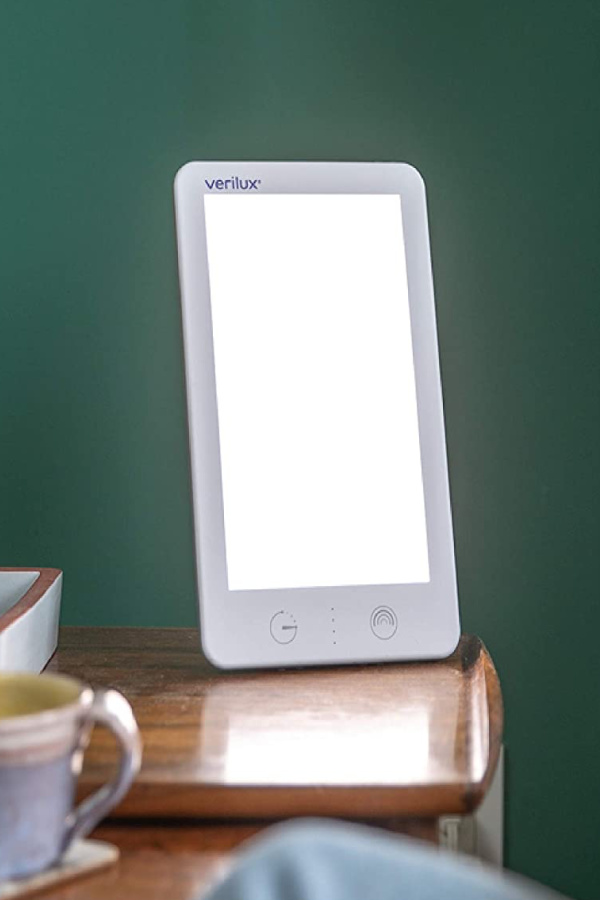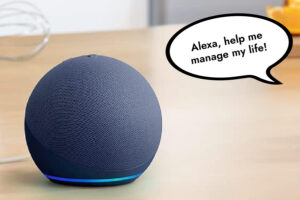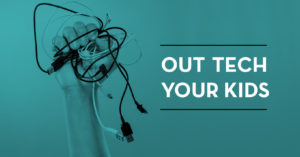So let’s talk about my absolute obsession with HappyLights, more technically known as light therapy lamps. I’ve always kind of dreaded the shorter daylight hours of the winter, knowing that Seasonal Affective Disorder tends to hit me hard. I get tired, cranky (sorry, colleagues), crave carbs up the whazoo, and have trouble staying up much past the kids do.
– This post has been updated for 2022 –
This post contains affiliate links and some purchases may help support our team at no additional cost to you
Related: 12 practical tech gifts to help get us through another long winter
So a few years back, after much begging from friends that I try the benefits of light therapy lamps, I spent more hours than you can imagine searching websites, cross-checking reviews, and finally nailing down the one light therapy lamp that seemed like it could help me over the long series of winter months: The Verilux HappyLight Liberty 10,000x Natural Spectrum Energy Lamp.
Mine is still going strong, and is now 50% under the original retail price. However, there are so many options and they’ve all come down in price. The Verilux HappyLight Lumi Plus would be my pick today, since it’s under $40 (on sale at Amazon right now) and has added features including adjustable brightness and a helpful countdown timer.
Here’s how I came to choose a Verilux HappyLight (odd photos of people in white jumping around on some tropical beach not withstanding) and what I’m liking about it.
And hey, if you find these days you can’t make it up much past the kids’ dinner — at oh, say 5:30 PM — or you realize you’re more snippy or distracted or carb-crazy than normal, I hope my experience will be helpful for you.
What to look for in a light therapy lamp

Here are the features I thought the Verliux HappyLight had going for it that I was specifically looking for:
– A 10,000 LUX output, which is the effective level recommended for the best results in treating winter blues, in pretty much all the research I read.
– White light wavelengths as opposed to blue light; white light has more research behind it. (However it does contain some blue light.)
– A few settings that let me limit output from 2,500 to 5,000 LUX so I could work my way up to maximum brightness gradually — the newer HappyLight models with adjustable brightness give you that ability too.
– A UV light filter with is an absolute must. If yours doesn’t have one, deal-killer.
– A fairly broad field of projection so I don’t have to be 6-inches from the lamp for it to be effective
– A minimum number of buttons or switches or gizmos or added features because, well, I’m already tired!
Related: Our favorite self-care apps to help you develop a self-care plan. Especially during winter.
The light therapy lamp I didn’t buy
I did consider tons of other options, including some popular blue light lamps (which I automatically nixed). Then I spent some time investigating the #1 selling Amazon option at the time, the NatureBright Suntouch Plus Light.
The slightly lower price was appealing (update: price isn’t so low anymore!) but in the end, the blue light output was a negative for me; and I admit I was greatly dissuaded by this very technical customer review that described undisclosed ozone output (eek) from the ionizer, some non-FDA approved claims ( “more effective than Prozac,” really?), along with other customer reports of nausea and headaches.
So…no.
There are lots of positive reviews of this light therapy lamp but lots of really negative ones too that go beyond, “it didn’t work.” Enough to make me keep looking.
Good lesson: The #1 best seller may not always be the #1 best product. Especially on Amazon these days.
Budget tip: whatever you do purchase, my feeling is, if you’ve got serious issues with Seasonal Affective Disorder, don’t let a $25 price difference among your top choices sway you. Go with the best possible lamp you can afford. Because saving $25 on something you’ll never use in the end comes out to wasting $75.
So, do light therapy lamps work?

As for the effectiveness of my Verliux HappyLight, I’m still using it after 6 years, so yes, I’m pretty impressed!
When I need it, I use it for about 30 to 45 minutes in the morning right after I wake up, when I’m online checking emails — you want to position it in front of you off to an angle to help stimulate all the rods and cones in your eyes.
I then may use it again for another 30 minutes in the afternoon at work, when I’m hitting a wall. (Jonesing for a vanilla latte or a cupcake craving out of nowhere is always a good indicator for me that I could use a little light therapy bump.)
Related: How this app can legitimately help with stress, anxiety, low energy, and sleeplessness
Okay, so I’m a convert!
Despite starting out as a big skeptic about this stuff, I can say in all honestly I’m feeling a discernible difference in my energy and sleep patterns after using a light therapy lamp. I mean, I’m not a scientist and I haven’t weaned off coffee so it’s not like I can give you definitive research to support my observation. (Nor do I know if there’s any placebo effect at play.)
But I do feel more alert with kind of a natural “buzz” that I like right after using it. And I really see the difference when I get that second afternoon session in, both in terms of my mood, more consistent energy levels, and the ability to actually stay up to a normal adult hour.
 No guarantee the HappyLight will make you as happy as the models on the Verilux site, but worth a shot.
No guarantee the HappyLight will make you as happy as the models on the Verilux site, but worth a shot.
There aren’t really many downsides from what I can tell so far. I would love a slightly smaller footprint for using it on my over-cluttered night table (if size is a factor, take a look at the Happy Mood Lamp from Circadian Optics), but it is still lightweight enough to take it easily to the kitchen, my desk, or the dining room table — you know, where half of us work these days.
A timer would be a nice-to-have but not a need-to-have, so I haven’t bothered to upgrade mine yet. There’s also a wall mount that I don’t see using, so — extra piece of plastic for the recycling bin.
But I can safely say my new light therapy lamp will be a permanent fixture in my life at least until April, so money well spent.
Sigh, will it ever be April?
Other links worth checking out for more info about light therapy:
It’s legit!
Light Therapy Tips from the Mayo Clinic
NIH Clinical Health Trials on Light Therapy
CAN-SAD study results of light therapy at the NIH






I agree, from personal experienec I can say that a bright light therapy lamp (10,000LUX) is very helpful for winter blues (SAD) and it’s not a huge effort.
You just have to read or do anything in front of it for 20-30 minutes in the morning and the mood-boost is well worth it.